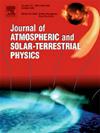Study of separation in junction frequency in vertical incidence ionogram traces observed at low-mid latitude Indian station, New Delhi: Ionosonde observations
IF 1.8
4区 地球科学
Q3 GEOCHEMISTRY & GEOPHYSICS
Journal of Atmospheric and Solar-Terrestrial Physics
Pub Date : 2025-02-01
DOI:10.1016/j.jastp.2024.106414
引用次数: 0
Abstract
Ionogram traces split into two modes, ordinary (O) and extraordinary (X), in the F-layer due to magneto-ionic splitting, where a transmitted pulse propagates in two distinct ways under the influence of Earth's magnetic field. The Earth's magnetic field causes ionogram traces to show double hop echoes when an echo is reflected back upward by the ground and then re-reflected by the ionosphere, demonstrating that the ionosphere is a doubly refracting medium. We have investigated the separation in Junction frequencies (JFs) of the O and X modes in vertical incidence ionogram traces observed over a seven-year period (2014–2020) during the declining phase of the solar cycle, from maximum to minimum. This difference in splitting in two modes is expected to be 0.67 MHz at low-mid latitude Indian station, New Delhi (28.6°N, 77.2°E). Anomalous separations of more than 21% in JFs were observed during the analysis. In these cases, we found over 30% anomalous cases of JFs in different seasons, with the highest occurrence in summer, followed by equinox and winter. JFs followed diurnal variation, with heightened variation during the solar cycle maxima and minimal variation during solar cycle minima. Lastly, we observed a concurrency between JFs and ionospheric perturbations caused by phenomena originating in both the lower and upper atmosphere.
在新德里低中纬度印度站观测到的垂直入射离子图迹中结频分离的研究:电离仪观测
在f层,由于磁离子分裂,电离图轨迹分裂成两种模式,普通(O)和特殊(X),在那里,在地球磁场的影响下,传输脉冲以两种不同的方式传播。地球磁场导致电离图轨迹显示出双跳回波,当回波被地面向上反射,然后被电离层重新反射时,表明电离层是一种双折射介质。我们研究了在太阳周期衰退期(2014-2020年)观测到的7年期间垂直入射电离图中O和X模结频率(JFs)的分离,从最大值到最小值。在低中纬度印度站新德里(28.6°N, 77.2°E),两个模式的分裂差预计为0.67 MHz。在分析过程中,观察到超过21%的JFs异常分离。在这些病例中,我们发现超过30%的JFs异常发生在不同的季节,其中夏季发生率最高,其次是春分和冬季。JFs呈日变化,在太阳活动周期最大值时变化较大,在太阳活动周期最小值时变化最小。最后,我们观察到JFs和电离层扰动之间的并发性,这些扰动是由起源于低层和高层大气的现象引起的。
本文章由计算机程序翻译,如有差异,请以英文原文为准。
求助全文
约1分钟内获得全文
求助全文
来源期刊

Journal of Atmospheric and Solar-Terrestrial Physics
地学-地球化学与地球物理
CiteScore
4.10
自引率
5.30%
发文量
95
审稿时长
6 months
期刊介绍:
The Journal of Atmospheric and Solar-Terrestrial Physics (JASTP) is an international journal concerned with the inter-disciplinary science of the Earth''s atmospheric and space environment, especially the highly varied and highly variable physical phenomena that occur in this natural laboratory and the processes that couple them.
The journal covers the physical processes operating in the troposphere, stratosphere, mesosphere, thermosphere, ionosphere, magnetosphere, the Sun, interplanetary medium, and heliosphere. Phenomena occurring in other "spheres", solar influences on climate, and supporting laboratory measurements are also considered. The journal deals especially with the coupling between the different regions.
Solar flares, coronal mass ejections, and other energetic events on the Sun create interesting and important perturbations in the near-Earth space environment. The physics of such "space weather" is central to the Journal of Atmospheric and Solar-Terrestrial Physics and the journal welcomes papers that lead in the direction of a predictive understanding of the coupled system. Regarding the upper atmosphere, the subjects of aeronomy, geomagnetism and geoelectricity, auroral phenomena, radio wave propagation, and plasma instabilities, are examples within the broad field of solar-terrestrial physics which emphasise the energy exchange between the solar wind, the magnetospheric and ionospheric plasmas, and the neutral gas. In the lower atmosphere, topics covered range from mesoscale to global scale dynamics, to atmospheric electricity, lightning and its effects, and to anthropogenic changes.
 求助内容:
求助内容: 应助结果提醒方式:
应助结果提醒方式:


